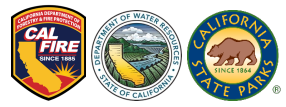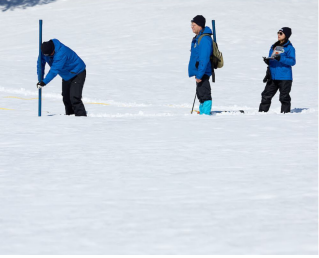SACRAMENTO— With this season’s statewide snowpack at 227% of average as of March 27, California State Parks’ Division of Boating and Waterways (DBW), the Department of Water Resources (DWR) and the California Department of Forestry and Fire Protection (CAL FIRE) are urging the public to take extra precautions and to be aware of cold-water dangers this spring to avoid a tragedy.
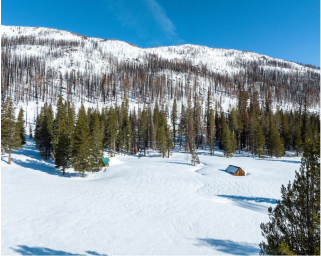
Aerial drone view of the deep snow that’s blanketed the meadow near Phillip Stations in the Sierra Nevada Mountains.
The series of winter storms is causing rising river and stream flow levels not seen in years. The eventual spring warm-up will bring fast flows and cold temperatures when all that snow starts to melt. All Californians are being encouraged to wait until summer to recreate in the water when conditions are safer.
“After successive low-water drought years, it is imperative that Californians understand water safety in and around rivers, streams, lakes and Sierra reservoirs. As the temperature rises, snowmelt-fed waterways can quickly induce incapacitating cold-water shock to even the strongest swimmers. We encourage everyone to follow the advice of public safety officials and avoid entering waterways if asked to do so.” State Parks Director Armando Quintero
“California has one of the largest snow packs on record. As this snowpack melts in the coming months, the waterways will be especially cold, fast and running higher than normal. Be aware of fluctuating water levels. We want everyone to always make safety a top priority when recreating.” DWR Director Karla Nemeth
“This year is very different from the last several years, in that the excessive snowpack and rain will continue to create challenges for us in the weeks and months ahead. Rising water levels in rivers and streams will be very cold, very fast and can easily overwhelm those that aren’t prepared or don’t heed warnings. Our teams will continue to focus on localized flooding risks, potential for major flooding, water rescues and our operational capabilities to support our communities moving into the spring and summer months.” CAL FIRE Chief Joe Tyler.
All three departments hope to educate regular water enthusiasts and occasional visitors to high, fast-running waterways who may venture near the edge to test the water or take selfies. Just one slip or unwatched child can become a devastating drowning statistic.
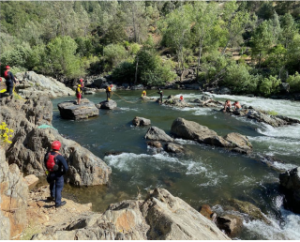
State Parks and CAL FIRE swift water teams rescued two stranded swimmers and a dog at Auburn State Recreation Area in June 2021. Photo from California State Parks.
Here are some key safety points to know before heading outdoors:
Plan Ahead
- Prior to leaving home, check the status of the park unit you want to visit to find out what restrictions and guidelines are in place.
- Know your GPS coordinates so you can provide your location in case of emergency.
- Alert someone where you are going and your expected return time. Be sure to let them know when you return safely.
Know the Water
- Do not enter cold, fast-running water. It can be dangerous not only to you but also to first responders.
- Many unseen obstacles can lurk below the water’s surface – especially with this year’s expected high runoff following low water years. Drought-stricken forests and storm-driven landslides have filled rivers with submerged trees and rocks. Swift water can make these obstacles even more treacherous.
- Sudden immersion in cold water can stimulate the “gasp reflex,” causing an involuntary inhalation of air or water and can start the drowning process immediately. It can even trigger cardiac arrest, temporary paralysis, hypothermia, and drowning.
- Never enter the water to rescue a victim. Throw something that floats and call 9-1-1.
Know your Limits
- Even the strongest swimmers may be easily overwhelmed when faced with cold, swift water. Do not enter the water, and never enter the water to rescue a victim.
Throw something that floats and call 9-1-1. - Swimming in open water is more difficult than in a swimming pool – people tire more quickly and can get into trouble.
- Never go on the water alone. Guided trips for solo or inexperienced floaters or paddlers are recommended if available.
Know about Life Jackets
- Although life jackets are strongly recommended when recreating in or near waterways, this year’s expected high runoff in rivers can be dangerous even with the use of life jackets.
- Conditions change quickly in open water, and even the best swimmers can misjudge the water and their boating or swimming skills. Wearing a properly fitted U.S. Coast Guard-approved life jacket can increase survival time.
- Learn more about life jackets at www.BoatCalifornia.com.
Know how to Supervise
- Actively supervise children in and around open bodies of water, giving them your undivided attention. Do not assume that someone is watching them. Appoint a designated “water watcher,” taking turns with other adults.
- Teach children that swimming in open water is not the same as swimming in a pool: they need to be aware of uneven surfaces, river currents, ocean undertow, and changing weather.
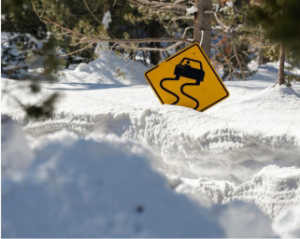
The “slippery when wet” sign along Hwy 50 in El Dorado County was nearly blocked by the recent snowfall.
Additional Resources
The public can find additional safety information at these weblinks:
• DBW’s Winter and spring boating and marine safety
• DWR’s Current River Conditions
• CAL FIRE all-hazard response
• Emergency Response: www.caloes.ca.gov
• Road Closures: QuickMap.dot.ca.gov
Subscribe to California State Parks News online at parks.ca.gov/newsroom.
The California Department of Parks and Recreation, popularly known as State Parks, and the programs supported by its Office of Historic Preservation and divisions of Boating and Waterways and Off-Highway Motor Vehicle Recreation provide for the health, inspiration, and education of the people of California by helping to preserve the state’s extraordinary biological diversity, protecting its most valued natural and cultural resources, and creating opportunities for high-quality outdoor recreation. Learn more at parks.ca.gov.
Facebook I Twitter I Instagram I YouTube I Blog
The Department of Water Resources manages California’s water resources, systems, and infrastructure, including the State Water Project (SWP), responsibly and sustainably. We strive to help Californians of all ages learn about water, including where it comes from, how we use it, and how to conserve it. We protect life and property from catastrophic events such as floods, drought, and dam or levee failure.
Facebook I Twitter I Instagram I YouTube
Beyond its wildland firefighting role, CAL FIRE is an ”all-risk” department. It may very well be a CAL FIRE engine and crew that is dispatched to the scene of an auto accident, or to a home where a child has become the victim of a drowning incident. The Department is always ready to respond – medical aids; hazardous material spills; swift water rescues; search and rescue missions; civil disturbances; train wrecks; floods, earthquakes, and more. We protect life and property from catastrophic events such as floods, drought, and dam or levee failure.
Facebook I Twitter I Instagram I YouTube

